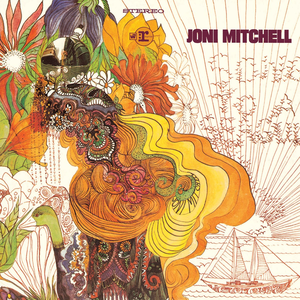 She’d already gotten royalty checks from other people doing her songs, but with this simple debut, Joni Mitchell became a household name. Accompanied mostly by an acoustic guitar in inscrutable tunings, her clear soprano weaves in and out of delicate melodies and allegories, mostly going back to the idea of a young woman finding her independent way in the world, repeatedly asserting her need to be “free”.
She’d already gotten royalty checks from other people doing her songs, but with this simple debut, Joni Mitchell became a household name. Accompanied mostly by an acoustic guitar in inscrutable tunings, her clear soprano weaves in and out of delicate melodies and allegories, mostly going back to the idea of a young woman finding her independent way in the world, repeatedly asserting her need to be “free”. While the album’s producer is listed as David Crosby, to this day he insists that his involvement consisted solely of keeping anyone from getting in her way, thus enabling her music to appear without distraction. Joni says that his inexperience guided his decision to have her sing into the piano, resulting in a mix that often sounds very murky. Luckily, it doesn’t hamper the quality of the music.
In classic album fashion, it’s split not only in two sides, but two themes, beginning with the city. From the first song, she proclaims where she’s already been (“I Had A King”) and declares repeatedly “I can’t go back there anymore.” But “Michael From Mountains” suggests that nothing is final. “Night In The City” turns up what little volume there is on the record, before the twin haunting portraits of lonely people in “Marcie” and “Nathan La Freneer”—the former a single woman, the latter a touchy cab driver.
Side two literally takes us down to the seaside, presumably by way of “Sisotowbell Lane”. “The Dawntreader” puts us on a ship, gently rocking through the verses. “The Pirate Of Penance” is tough to follow without the lyric sheet; someone may or may not have been murdered, but there has certainly been a seduction. “Song To A Seagull” restates the theme of each of the album sides, putting us back on a boat and soaring overhead. The final chord is exhilarating. But it’s “Cactus Tree” that will stick in your brain, not just because it’s the last song on the album, but because of its portrayal of a woman, despite the best efforts of several suitors, who’s simply “too busy”—and therefore happy—“being free.”
Song To A Seagull is the album’s actual title, spelled out by the birds on the cover, though it was known simply as Joni Mitchell for about thirty years. The mistaken title works just as well. It is her own creation, right down to the artwork. This is a special album, and set a high mark for her to follow.
Joni Mitchell Song To A Seagull (1968)—4½
No comments:
Post a Comment